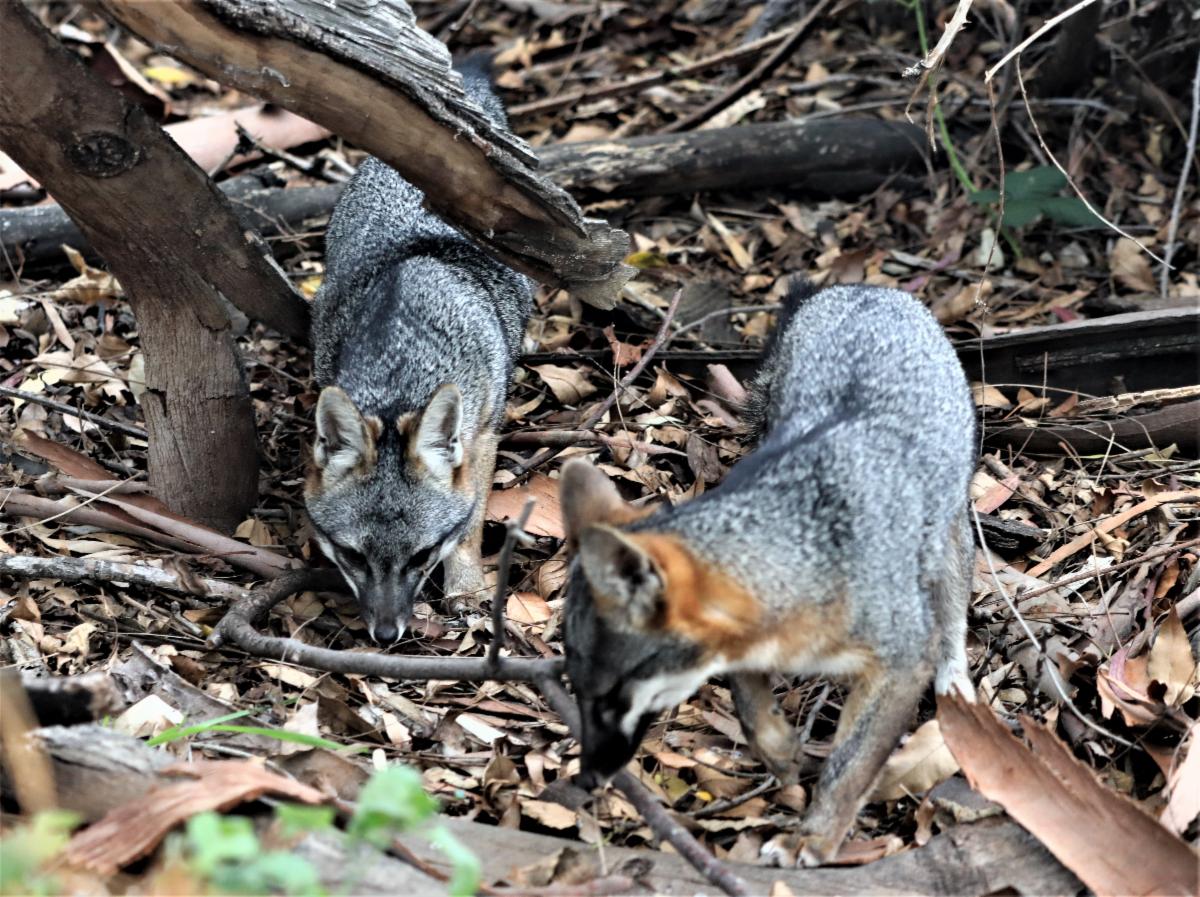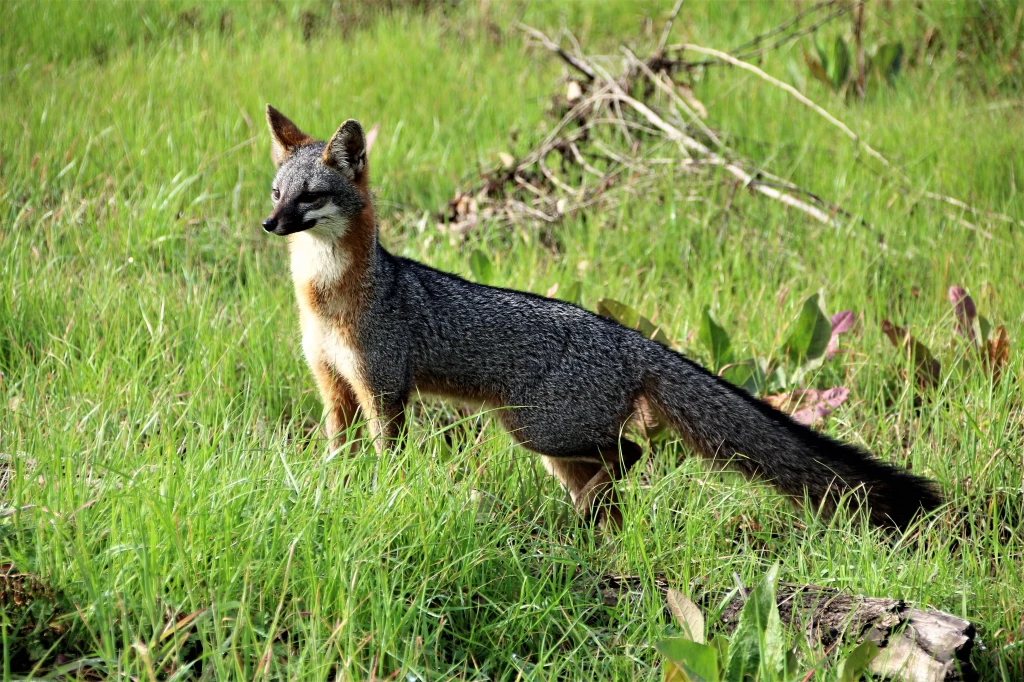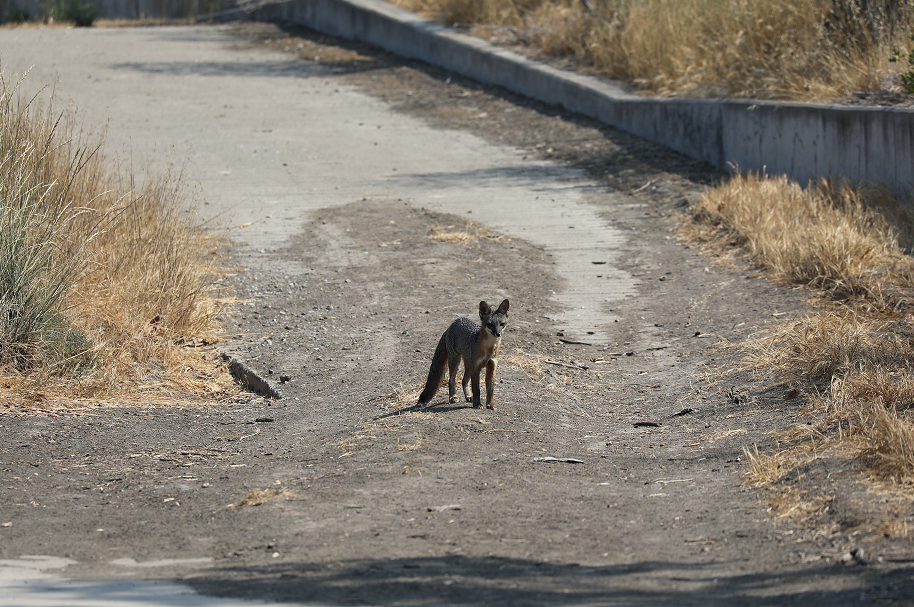Flood or Windstorm: Which One Affects Wildlife More?
by William C. Leikam
President, CEO & Co-founder, Urban Wildlife Research Project
Section I
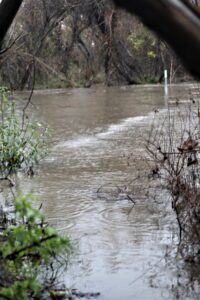 In my January account of the foxes, I showed how, even with flooding and high waters everywhere that the foxes, the raccoons and most all other critters took that flooding in stride and came through without a serious hitch in their daily lives. For instance, the gray foxes continued to show up before cameras that were not out in the floodwater, and the raccoons continued to forage along the high water’s edge. Opossums continued to show up along Pond Road. The gray fox pair Laimos and Big Eyes found passage from the creek over into the water treatment plant area about .78 of a mile away given the shortest route, or 1.19 miles on the farthest trek.
In my January account of the foxes, I showed how, even with flooding and high waters everywhere that the foxes, the raccoons and most all other critters took that flooding in stride and came through without a serious hitch in their daily lives. For instance, the gray foxes continued to show up before cameras that were not out in the floodwater, and the raccoons continued to forage along the high water’s edge. Opossums continued to show up along Pond Road. The gray fox pair Laimos and Big Eyes found passage from the creek over into the water treatment plant area about .78 of a mile away given the shortest route, or 1.19 miles on the farthest trek.
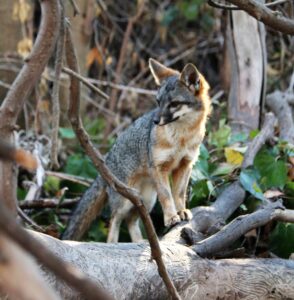 On Tuesday February 21 and Wednesday February 22, 2023 a powerful windstorm hit the baylands, felling trees, especially the dead willows along Matadero Creek but also a few live trees that could not stand up against those near hurricane blasts of wind that NOAA reported to be upward of 75 miles per hour.So, in January we have flooding and in February we have a 24-hour windstorm. Those two events brought up the question which of these two events effected the wildlife at the baylands the most? We already know something about how the foxes, etc. held up with the flooding, (See Gray Fox Report January, 2023) but the windstorm was an altogether different matter.
On Tuesday February 21 and Wednesday February 22, 2023 a powerful windstorm hit the baylands, felling trees, especially the dead willows along Matadero Creek but also a few live trees that could not stand up against those near hurricane blasts of wind that NOAA reported to be upward of 75 miles per hour.So, in January we have flooding and in February we have a 24-hour windstorm. Those two events brought up the question which of these two events effected the wildlife at the baylands the most? We already know something about how the foxes, etc. held up with the flooding, (See Gray Fox Report January, 2023) but the windstorm was an altogether different matter.
If we use the trail cameras as a rough measure of the difference between the flooding and the wind, the following is a snapshot of a night of torrential rainstorm and a major windstorm:
Trail cameras During Rainstorm – Sunday December 31, 2022. (One of nine atmospheric rivers, late December 2022 into January 2023.) Trail cameras During Windstorm – Tuesday February 21 All accessible cameras had files, but not all cameras were accessible.
Total number of files in all cameras: 56No files in cameras #1, #9, #5
Total number of files in all cameras: 34
As an example, from the Gray Fox Log, “Last night I documented the wind. Camera #5 that looks down into the Matadero Creek water near the ditch…, there were 152 files before the SD card was filled. Out of that I saved 5 files, all of which were of the wind blowing through. No critters.Camera #10 which usually gets on the average anywhere between 3 – 8 files had 139 files and I kept 4 files and no critters. Camera 12 which usually has 3 – 5 raccoons passing had no files on the card.”
Frequently, the number of files on a calm, dark night will run from a low of about 70 to around 120 files but on occasion that number can be upward of 175 files. By contrasting the two events, the windstorm seems to have had the greatest impact on the wildlife at the baylands. I would speculate that just from the sounds of trees breaking, large branches landing nearby, the wind itself blasting through the trees, that due to all that noise impacted the wildlife far more than the flooding.
Section II
Update for the Urban Wildlife Research Project
Stay In Touch: Check us out on YouTube, Facebook, and LinkedIn to stay in the loop on our conservation activity, event announcements, and updates from gray foxes Big Eyes and Laimos in the Palo Alto Baylands!
Upcoming Event: On March 21st, 2023, Bill the Fox Guy Leikam will be speaking at Stanford’s Jasper Ridge Biological Preserve.
Coming Soon: Look forward to a soon-to-be released video documentary about Bill’s participation in the global research project Triggered By Motion, and his once-in-a-lifetime opportunity to travel all the way from California to Zürich, Switzerland, to see the breathtaking exhibition in person.
Coming Soon: Bill will be interviewed later this month by Dr. Annabelle Dufourcq, Associate Professor of Metaphysics and philosophical anthropology, Philosophy, Theology and Religious Studies at Radboud University Nijmegen, The Netherlands — for a project of her’s on ethology.
In The News: We’ve made a new discovery and documented the first beavers to occupy Matadero Creek in 160 years. Palo Alto Weekly, the San Jose Mercury News, and the Santa Cruz Sentinel.This story was syndicated nationally.
Available Now: Bill’s book The Road to Fox Hollow has been released and can be found at Barnes & Noble Booksellers and directly from the publisher Di Angelo Publications. Available Now: Learn more about Bill’s work with the foxes in The Foxes, My Professors, a video documentary produced at Stanford University by Syler P.R.
Available Now: Learn more about The Social and Emotional Lives of Urban Gray Foxes in an interview with Bill conducted by Dr. Marc Bekoff on Psychology Today. Available Now: Learn more about Bill’s ethological approach to his study of the gray fox in Bay Nature Magazine’s How to be a Fox. Many are calling this a major article in the wildlife press.
Available Now: Undoubtedly our best Radio interview ever – Bay Area Wildlife Habitats Are Disappearing. Fox Guy Has A Plan – KALW (PBS program Crosscurrents) – by Sofie Kodner during December 2020 – Broadcast 1/11/2021 5:00 PM.
Section III
Gray Fox, Baylands Goals
Within the permit that allows the Urban Wildlife Research Project to conduct its study of the behavior of the gray fox at the Palo Alto Baylands Nature Preserve, the objectives covered area:
- Monitoring of urban gray fox Denning sites in Palo Alto Baylands.
This is being accomplished during the period when the gray foxes use a den site. It is one of the prime locations for gathering most of the behavioral data of the litter and for adults alike.
- Assessment of status and population trends of Baylands urban gray foxes
Since January 2019 a pair of resident gray foxes have claimed territory at the Palo Alto Baylands Nature Preserve.
- Identification of habitat features that promote the presence of urban gray foxes
After considering this and talking with people who know how to restore habitats, we need to assess what kinds of plants, including the Alkaline Salt Bush, would grow best along the edge of the saltwater channel and alongside the marsh. We need to grow a permanent habitat that contains the corridors and plant it as soon as possible. We’ll keep an eye on this as this is a critical link between the southern region of the Baylands and the northern region.
- Assessment of reproductive success and identification of factors that promote successful reproduction
Open up the pinch-point along Matadero Creek by developing thickets that link one area to another, instead of the present “islands”.
- Identification and assessment of possible dispersal travel routes.
Presently there can only be guesses as to dispersal travel routes. We intend to make this important question much more concrete when we attain our collaring/take/capture permit from the Department of Fish & Wildlife.

